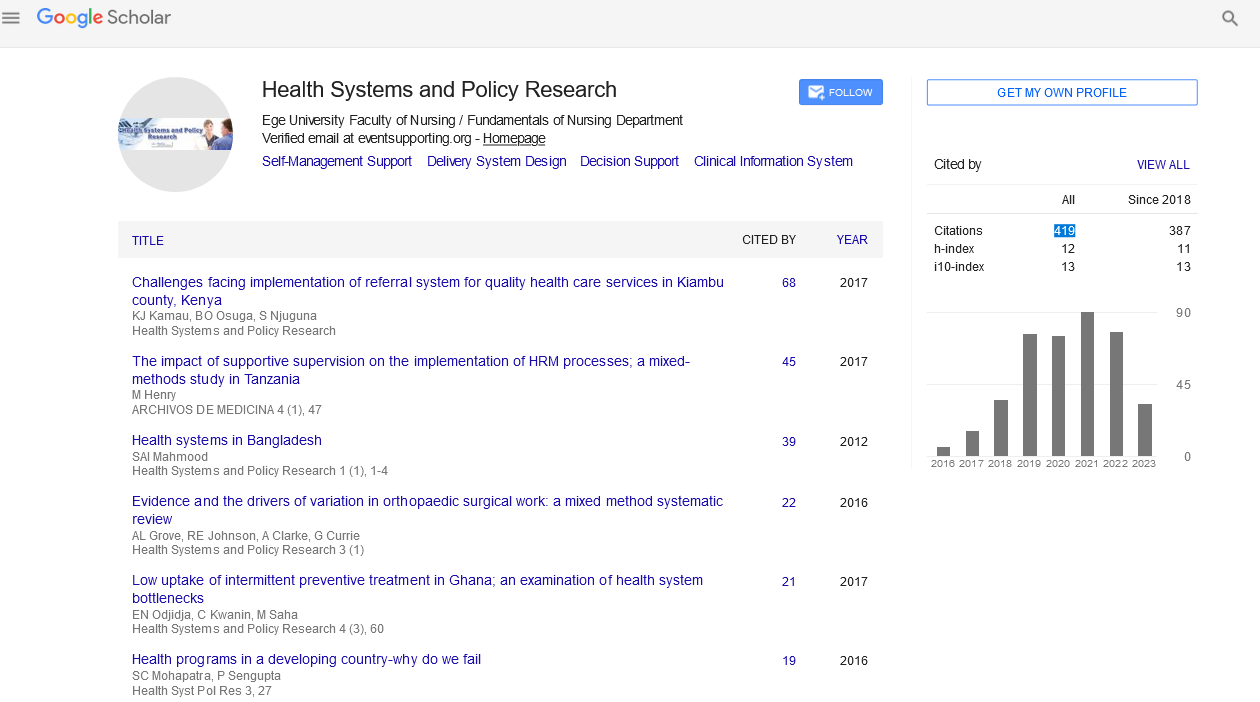Perspective - (2023) Volume 10, Issue 6
The economics of healthcare: Challenges and solutions
Tsuneo Hashizume*
Department of Healthcare Management, University of Foyo, Tokyo, Japan
*Correspondence:
Tsuneo Hashizume, Department of Healthcare Management, University of Foyo, Tokyo,
Japan,
Email:
Received: 13-Nov-2023, Manuscript No. iphspr-23-14136;
Editor assigned: 17-Nov-2023, Pre QC No. P-14136;
Reviewed: 01-Dec-2023, QC No. Q-14136;
Revised: 18-Dec-2023, Manuscript No. R-14136;
Published:
26-Dec-2023, DOI: -
Introduction
Healthcare is a fundamental aspect of human well-being
and its importance cannot be overstated. Access to quality
healthcare is not only a matter of public concern but
also an economic one. Health economics, a subfield of
economics, delves into the economic aspects of healthcare
systems, policies and the allocation of resources to
achieve efficient and equitable healthcare delivery. These
factors include inappropriate and/or overutilization of
medical care, regional variation in services and spending,
administrative inefficiency associated with the various
components of the patient interface, a growing uninsured
population, insufficient preventive services. In this article,
we will explore the intricate world of health economics,
highlighting the challenges faced by healthcare systems
worldwide and proposing potential solutions to address
them.
Description
Rising healthcare costs
One of the most significant challenges in health economics
is the escalating cost of healthcare. The cost of medical
treatment, medications and healthcare services has been on
a continuous upward trajectory. This increase in healthcare
costs affects individuals, families and governments, posing
a considerable economic burden.
Factors contributing to rising healthcare costs include
advancements in medical technology, an aging population
and the administrative expenses of healthcare systems.
High-tech medical procedures and treatments, while often
life-saving, come with exorbitant price tags. Additionally,
as the population ages, the demand for healthcare services
increases, driving up costs.
Potential solutions: Encouraging competition among
healthcare providers can help drive down costs through
market competition. Promoting preventive care and healthy
lifestyles can reduce the demand for costly treatments.
Implementing price transparency and consumer education
can empower patients to make informed choices about
their healthcare.
Healthcare access disparities
Access to healthcare is another critical aspect of health
economics. Disparities in healthcare access are often rooted in socioeconomic factors, geography and race, leading to
unequal health outcomes. In many countries, marginalized
populations face barriers in accessing necessary healthcare
services.
Low-income individuals, racial and ethnic minorities and
people living in rural areas often experience reduced access to
healthcare due to a lack of insurance, limited transportation
options or insufficient healthcare infrastructure in their
communities.
Potential solutions: Expanding access to healthcare
through programs like medicaid and the affordable care act
(in the United States) can help reduce disparities. Investing
in telemedicine and mobile healthcare units can bridge
geographical gaps and provide services to underserved
areas. Initiatives to address social determinants of health,
such as education and housing, can contribute to reducing
disparities in access.
Quality of care
The quality of healthcare is not solely dependent on its
availability; it also concerns the effectiveness of treatment
and the patient experience. Ensuring that healthcare
services provide value for the money spent is a central
concern in health economics. Quality-related challenges
in healthcare include medical errors, overuse of healthcare
services and variations in care delivery.
Potential solutions: Implementing quality control
measures and healthcare guidelines can reduce medical
errors. Promoting evidence-based medicine can discourage
unnecessary treatments and reduce overuse. Encouraging
the use of electronic health records and data analytics
can help identify variations in care and target areas for
improvement.
Healthcare insurance and financing
The financing of healthcare is a complex issue, with
multiple stakeholders involved, including governments,
private insurers and individuals. Health insurance coverage
is crucial for ensuring that individuals have financial
protection in case of illness or injury. However, gaps in
coverage and the structure of healthcare financing systems
can lead to economic challenges.
Potential solutions: Moving towards universal healthcare
systems can reduce administrative costs and ensure broader
coverage. Implementing value-based insurance design
can make essential services more affordable for
individuals. Addressing the rising costs of prescription
medications through pricing regulation and transparency.
Aging population
The demographic shift towards an aging population presents a unique economic challenge for healthcare systems. As
people live longer, they often require more medical care
and long-term care services. This demographic trend can
strain healthcare budgets and resources, particularly for
pension and social security systems.
Potential solutions: Encouraging healthy aging through
preventive care and promoting active lifestyles can
reduce the burden on healthcare systems. Developing
innovative long-term care models, such as home and
community-based care, can be cost-effective alternatives
to traditional nursing homes.
Technology and innovation
While medical advancements and technological
innovations have improved healthcare outcomes, they have
also contributed to rising costs. New medical technologies,
such as gene therapy and precision medicine, can be
incredibly expensive. Balancing innovation with costeffectiveness
is a constant challenge in health economics.
Potential solutions: Encouraging value-based pricing
for innovative treatments to ensure that the cost
aligns with their clinical benefits. Promoting
competition and transparency in the pharmaceutical
industry to lower drug prices. Investing in health
technology assessment to evaluate the cost-effectiveness of
new medical technologies.
Behavioral factors and lifestyle choices
Behavioral factors and lifestyle choices significantly
impact overall health and healthcare costs. Smoking,
poor diet, lack of exercise and substance abuse can lead
to chronic conditions and increased healthcare
utilization.
Potential solutions: Implementing public health
campaigns and interventions to promote healthier
behaviors. Offering incentives, such as wellness programs,
to encourage individuals to adopt healthier lifestyles.
Conclusion
Health economics plays a vital role in shaping the future
of healthcare. It involves a delicate balance between
providing access to quality care and managing the
escalating costs associated with it. As healthcare systems
grapple with these challenges, innovative solutions are
needed to ensure that individuals receive the care they
need without breaking the bank. By addressing rising
costs, disparities in access, quality of care, insurance
and financing, demographic shifts, technological
innovation, workforce shortages, behavioral factors
and system efficiency, we can pave the way for a
healthier, more economically sustainable future.





